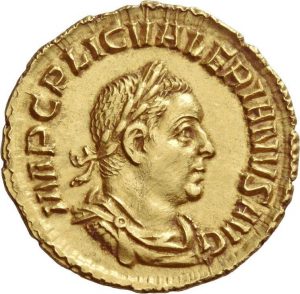| Valerian | |
|---|---|
 |
|
| Roman Emperor | |
| In Power | Sep 253 – Jun 260 |
| Born | c. 199 |
| Died | Between 260-264 |
| Wife | Mariniana Cornelia Gallonia |
Publius Licinius Valerianus, more popularly known as Valerian, was born between 193 and 200. His place of birth is unknown, but it is known that his family comes from a senatorial background. Valerian married Egnatia Mariniana, who bore him two sons, Publius Lincinius Egnatius Gallienus and Valerianus Minor.
Rise to Power
Valerian had enjoyed the trust of emperors he had served before becoming emperor himself. He was appointed as a censor by Emperor Decius, who tried to revive the people’s moral and religious values. Trebonanianus Gallus, who succeeded Decius, designated Valerian to ward off Persian invaders who had become bolder and stronger under their king, Shapur I. However, before Valerian could go about this task, Gallus asked him to head down to Rome with his army and help him fight a commander-turned-rebel named Aemilianus. Aemilianus had been declared emperor by his soldiers after wiping out Gothic invaders and was now marching towards Rome to seize the throne. Valerian arrived too late, as Gallus had been killed by his own men even before a clash with Aemilianus happened. With Gallus dead, Aemilianus was now emperor.
Valerian’s men, on the other hand, proclaimed him emperor, and they continued their move towards Rome. Aemilianus’ men, fearing that Valerian’s much larger army would butcher them, stabbed their leader to death. The Senate then expressed its support for Valerian by proclaiming him emperor.
Reign
As emperor, Valerian immediately granted the status of co-emperor to his son, Gallienus. Following this, he tried to gain popularity by reviving the persecution of Christians. For years now, Christians have been refusing to offer sacrifices to the Roman gods. Because of this, Valerian ordered the execution of many more Christians, including Pope Sixtus, whom he had beheaded.
Meanwhile, the Sassanids, who were now ruling in Persia, were wreaking havoc in the eastern part of the Roman empire. They were led by their king, Shapur I, and had seized control of Armenia and Antioch. Valerian left the management of Rome to his son, Gallienus, while he set out to crush the Sassanids. After a few years of fighting, Valerian successfully reclaimed Antioch. But, on hearing that the Sassanids would be invading Edessa, he decided to march his troops there.
Valerian’s decision turned out to be a grave mistake. A plague broke out after arriving in Edessa, decimating the city’s population and wiping out most of Valerian’s army. When Valerian clashed with Shapur I, his army was easily defeated. Valerian now wanted a settlement to end the war and arranged a meeting with the Sassanid leader. Shapur, I agreed to this meeting but was playing a game of deception. Valerian and his men were soon captured by the Sassanids, leaving Gallienus alone on the imperial throne.
Death
After his capture, no credible news about Valerian was ever heard. However, the Christian historian, Lactantius, wrote that “The king of the Persians, who had made him prisoner, whenever he chose to get into his carriage or to mount on horseback, commanded the Roman to stoop and present his back.” Valerian was said to have endured this treatment for a long time before he offered a huge ransom for his freedom. Shapur I responded to this by having liquified gold poured into Valerian’s mouth and down his throat. After this, Roman’s skin was peeled off of him and was, stuffed with straw and displayed in a Persian temple. Historians, though, have not given much weight to Lactantius’ claims, as he was a Christian who hated Valerian’s persecution. Lactantius may have wanted people to think that the Christian god punishes those persecuting Christians. The Iranian historian, Touraj Daryaee, paints a different picture, wherein Shapur I held Valerian and his men inhumane conditions, either in Shapur or Gundishapur, and even used the men in construction projects.